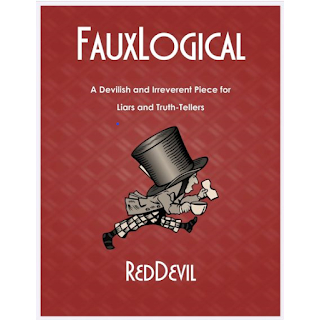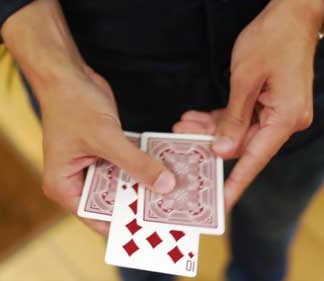Description
FAUXLOGICAL
RedDevil is back! After disappearing from the magical arts (he was kidnapped by life and taken to a “Hell” that not even a RedDevil can enjoy), he returns to earth with a brand new eBook of close-up mentalism!
“I had no idea how he could have any valuable information…The more I thought about it, the more perplexed I was. It was IMPOSSIBLE. There was absolutely no way he could know anything.”–Madison Hagler, author of the Bang! chair test
It’s called FAUXLOGICAL, and it is DIABOLICAL!
Why? Well, while laymen spectators will definitely enjoy the basic routine (and will definitely be fooled!), this book was designed as a challenge experiment:
Take a well-known plot (actually two plots) in mentalism and design a routine that could fool spectators who know the plot backwards and forwards–MENTALISTS and MAGICIANS!
In essence, this routine is unapologetically designed as a rope-a-dope for mentalists who want to perform a routine for their peers at the magic club that “appears” to be run of the mill, but then gives them a surprise that will cause them to think and say, “Wait a minute…”
What is FAUXLOGICAL? Well, it’s not just a one-off routine. It’s an eBook in two parts.
“Fauxlogical is a lovely addition to this genre of effects. It’s the sort of thing I really enjoy because it can be performed completely impromptu and adds further options to your toolkit.”–Sudo, author of Mental-Diemensional and Hoshi’s Lucky Star
SECTION ONE:
The first part is a very familiar effect, a which-hand routine using the liar/truth-teller “engine.”
But that’s where it ends. Even though they know you are using the logic puzzle to “get” them, your colleagues still won’t know how you did it.
How? Because it is a brilliant new method?
No. In simple terms, it will fool many of them because the method is far more, shall we say, analogue. Yet, they will be trapped in their own knowledge of a thousand routines like it. The logic questions are crucial, but they are not the core method. How can that be?
“RedDevil showed me this, and I was sent down the rabbit hole only to emerge without a clue. This is a very clever use of simple principles that are not the ones that you assume are being used. This is certainly a magician fooler, but not at the expense of the experience for laymen.”–Mark Chandaue, author of Harpacrown
SECTION TWO:
For those of you who like to collect neat little mentalism tools and principles, you are going to LOVE this part. Section TWO is a tool chest full of little devices you can use in a thousand routines.
Using the routine in the first section as a template, I will offer you a clinic on how to utilize some interesting little “pieces of devilry” (read: impromptu mentalism principles) that were not used at all in the original routine.
They are not only completely different methods in achieving the original routine, but they are also principles that you can use to create your own routines for decades!
Thus, this eBook is not just a routine in Section One, but a treatise on what happens when you take a simple method (in Section One) and layer it with other principles (in Section Two).
- No st88ges or uses of sound cues.
- No Equ888888 or Du88 Rea888 or Ou8s.
- No p**ks of the identity of the three coins.
- No gimmicked items. All items can be borrowed and in performance in seconds. .
- The spectator’s chosen coin for the performer to divine is a totally free choice and could be in any of the two hands when she names it.
- Since each one of the individual three coins has the possibility of being located in any hand by free choice of the spectator and since the spectator can freely name any coin, the result can truly be different each time.
- There are no crazy mathematical principles or switching procedures involved except for the Liar/Truth-Teller approach already mentioned.
- Works with coins from any country.
- Four Routines:
- Fauxlogical
- Zombie Faux-Quivoque (FOE QUA VOKE)–Designed as both a routine for laymen, but also a conversation piece for fellow mentalists. If the latter, the mentalist spectator is given four coins and has a series of choices that look like Equ*****e. But each time, the performer corrects himself and gives the spectator a fair and defined choice instead. In the end, the performer proves he can divine the choices every time!
- Right-Left Roulette–The spectator is given 4 coins and told that three of them are poison and only one single coin is safe. Three business cards are on the table the entire time, and the last one has a coin hidden underneath. She chooses one of the four coins in a very fair manner and is even allowed to change her mind in the end. Even so, the coin under the card matches her ultimate prediction…and saves her life!
- Faux-as-I-Faux–The performer and spectator each hold four different coins, two in each hand, standing back to back. The spectator arranges the coins freely in any hand she chooses. Demonstrating his skill to influence her choices, the performer invites her to play a game of blind do-as-I-do, moving coins from one hand to the other…and free choices are commanded by the spectator! Even so, they impossibly end up with the same coins in each hand.
- Coaching Clinic in Section Two on the use of mulitple tools that you can use with coins and small objects (and other things!) for mentalism routines.




